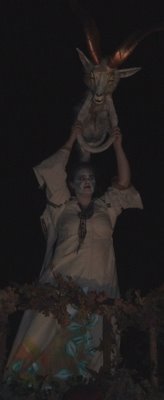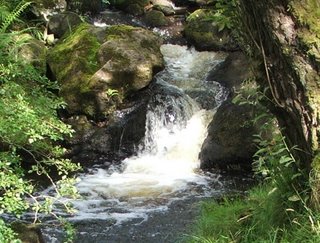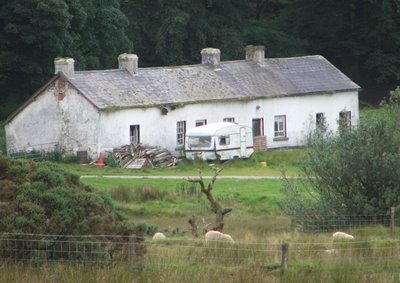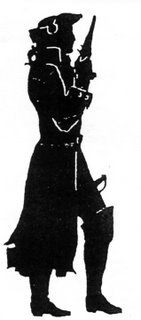 (Official War Portrait of Commander William AE King RN by William Dring)
(Official War Portrait of Commander William AE King RN by William Dring)Last Wednesday, I was privileged and humbled to be able to act as chauffeur and minder to one of the last surviving British heroes of World War Two. For I had to collect and drive the much decorated Commander William (Bill) King RN to and from the official opening of the new Marine Science school Lab at Ireland's National Aquarium (
Atlantaquaria) in
Salthill where he was special guest of honour.
At the ripe old age of 96 Bill is extremely gregarious, energetic, full of wit and charm, enjoys the odd tipple(!) and can keep you spellbound with his daring and oftentimes witty tales of exploits from war-time. His stories seem to be taken straight of a British public boys' school novel of the late 1940s.
Bill was one of the very few British submarine commanders that started the war in 1939 who was still alive in August 1945. The death rate in the Royal Navy submarine fleet was proportionally as high as that of the more well-known
Kreigsmarine. His exploits are legendary:
- shelling a Japanese gun-ship and troop transport ship which he was later reprimanded for by the British Admiralty ("... I was told that I should have used torpedoes!...")
- leaving Singapore just prior to its capitulation when his crew survived for circa 40 days at sea on a few boxes of Australian lozenges that they hurriedly scavenged from the city's dockside ("...everyone remarked how thin we were...")
- arriving at Ceylon where they soon found themselves attacked by dive-bombers from the Japanese fleet ("...I could plainly see the whites of the pilots' eyes as they wheezed past...")
- managing to extricate his submarine from being grounded on the coast of Nazi-occupied Holland ("...I got the helmsman to turn the wheel strongly to starboard every time a wave came inshore...")
- surfacing to replenish his air tanks off occupied Norway ("...I would surface right up against the base of the cliffs so as to avoid the view of any watching sentries...")
- the madness that engulfed the Asian port where he was docked the night the war ended ("...60 people died on shore that night as people got extremely drunk, lost their heads with some settling years of pent-up frustrations and old feuds with guns...")
- the egalitarian world of the submarine ("...I was born into the British upper class, but one positive thing that serving on a submarine did for me, was it eliminated any inherent snobbishness that I had...as we all lived together in cramped quarters sharing everything!...").
- decorated by Winston Churchill ("...Winston kept offering me a shot of his fine house brandy which I kept declining...").
 (Bill's first submarine posting was on the HMS Orpheus in 1931. Picture shows the submarine in Hong Kong Harbour)
(Bill's first submarine posting was on the HMS Orpheus in 1931. Picture shows the submarine in Hong Kong Harbour)
Bill is connected by marriage to one of the great Anglo-Irish aristocratic families. His wife Anne's ancestral home is Castle Leslie in
Monaghan where ex-
Beatle Paul McCartney and Heather Mills got married. Anita (or Anne) was first cousin to Winston Churchill ("...our families shared the same baptismal clothes..."). According to Bill, his father Lt. Col William Albert de Courcy was the first man to fly an airplane in Europe at the site of what is now the world-renowned
Farnborough airshow). His grandfather William was first Professor of Geology at Queens' College Galway (now NUI Galway) and is famous for coining the term ’Neanderthal man’ in 1865 after deducing that the fossil remains found at the River Neander in Germany belonged to a non-human species whom he called
Homo neanderthalensis.But Bill also has good Irish nationalist credentials!-Anita's godfather was Eamon De Valera with her father being a good friend of the Irish rebel leader Michael Collins. She in fact served as an ambulance driver with the French Army in WW2 and was
awarded the coveted '
Croix de Guerre' by Charles de Gaulle ("...she was very courageous and joined the French rather than the British ambulance service because the French went closer to the front-line...!").

After the war, Bill moved to Ireland and purchased
Oranmore castle located on the shores of
Galway Bay for £200. It was then in an advanced state of disrepair. But within a short time frame, this fine medieval building once more echoed to the sounds of human habitation.
But his love of adventure at sea never left him. In 1969 he took part in the first 'round-the-world' yacht race on his boat 'The
Galway Blazer'.
Last month, he was decorated with the newly created '
Arctic Emblem' by the British Ministry of Defence, given to those military personnel who had served in the Arctic regions during WW2.
Two years ago, I helped the pupils from a nearby primary school (
Kiltartan) film a fascinating interview with Commander King as part of the '
Fionn'
Galway Primary School Science project. This can be viewed at www.sci-spy.ie/fionn_films/03.aspx . Well worth a view!
"...What shall we do with the Singing Sailor....!"
Finally, as a footnote....
As I said , I acted as chaperon to Bill when he was special guest at the
Atlantaquaria reception. While there, he enjoyed two glasses of white wine which seemed to make him a little merry. For on the one hour's journey back to his castle home, he gave a non-stop rendition of ditty little sexy rhymes and songs of WW2 vintage along the lines of
"...There was a lusty young maid from Algiers who....". All very enjoyable and funny, except for the fact that my 6 year old son was also in the car! I kept gracefully reminding the commander that the young lad was present but to no avail! Thankfully
Dáire didn't understand most of the more inappropriate words that he was reciting (or at least I don't think that he did!!!).

 I must be living on a different planet to the people in 'Irish Business Against Litter' (IBAL)!
I must be living on a different planet to the people in 'Irish Business Against Litter' (IBAL)! far and wide which has changed little from my own personal survey of a few months ago. See what I found on the website- www.greenwatchgalway.blogspot.com
far and wide which has changed little from my own personal survey of a few months ago. See what I found on the website- www.greenwatchgalway.blogspot.com















































